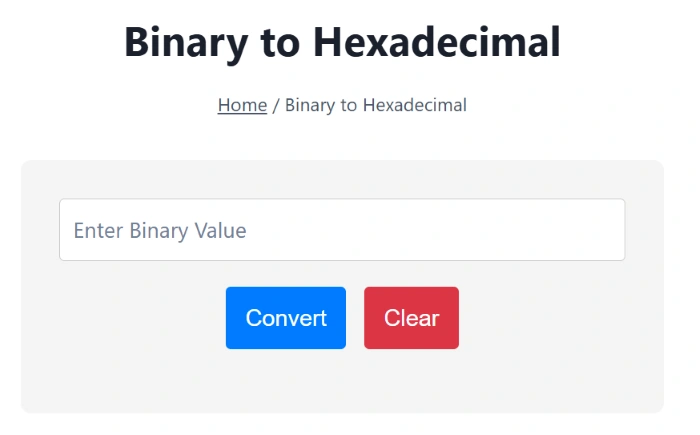Binary to Hexadecimal
Reverse Conversion Tool: Hex to Binary Converter
Easily convert binary numbers (base-2) to hexadecimal (base-16) using this free online tool. Whether you’re a student, developer, or tech enthusiast, this converter makes binary to hex conversion fast and accurate.
What Is Binary to Hexadecimal Conversion?
Binary numbers use only two digits — 0 and 1 — and are the foundation of all digital systems. Hexadecimal numbers, on the other hand, use 16 characters (0–9 and A–F), offering a more compact way to represent binary data.
Why convert binary to hex?
- Simplifies reading long binary strings
- Used in programming, memory addresses, and digital electronics
the binary to hexadecimal converter is shown below

How to Convert Binary to Hexadecimal?
To convert binary to hexadecimal manually:
- Start from the right and group the binary digits into sets of 4 bits
- Convert each group into its corresponding hexadecimal digit
For other conversions like hex to binary or hex to decimal, explore all available tools on our hex calculator homepage.
Binary to hexadecimal formula:
Group of 4 binary digits → 1 hexadecimal digit
An infographic explains how does Binary to hexadecimal work is shown below:

Binary to Hexadecimal Conversion Example
Example: Convert 10101100 to hexadecimal
- Step 1: Group:
10101100 - Step 2: Convert:
1010= A1100= C
- Result: AC
Need more help? Try our Binary to Hexadecimal Converter with solution above to see step-by-step breakdowns.
Binary to Hexadecimal Table
| Binary (4 bits) | Hex |
|---|---|
| 0000 | 0 |
| 0001 | 1 |
| 0010 | 2 |
| 0011 | 3 |
| 0100 | 4 |
| 0101 | 5 |
| 0110 | 6 |
| 0111 | 7 |
| 1000 | 8 |
| 1001 | 9 |
| 1010 | A |
| 1011 | B |
| 1100 | C |
| 1101 | D |
| 1110 | E |
| 1111 | F |
Use this binary to hexadecimal table as a quick reference while converting manually.
Binary to Hex in Python
Want to automate it? Here’s how you can convert binary to hexadecimal using Python:
pythonCopyEditbinary = "10101100"
hex_value = hex(int(binary, 2))[2:].upper()
print(hex_value) # Output: AC
This is useful in scripting, computer programming, and data processing.
Related Tools and Converters
- Hexadecimal to Decimal Converter
- Decimal to Hexadecimal Converter
- Hex to ASCII Converter
- ASCII to Hex Converter
- IP to Hex Converter
- Hex to IP Converter
- Hex to Base32 Converter
- Base32 to Hex Converter
- Hexadecimal Shift Calculator
- Hex to UTF8 Converter
- UTF8 to Hex Converter
FAQs – Binary to Hexadecimal
Q: What is the hexadecimal equivalent of 11110000?
A: Grouped as 1111 0000 → F0
Q: How do I convert binary to hexadecimal without a calculator?
A: Use the grouping method: 4 binary digits = 1 hex digit.
Q: Why is hexadecimal used instead of binary?
A: It’s shorter, more readable, and easier for humans to understand.
